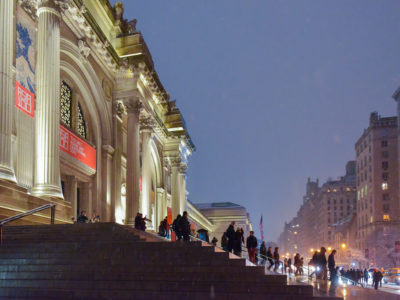The Metropolitan Museum of Art Intern, New York City
Whenever my teacher said “fieldtrip,” the whole class heard “no school.” But as for me—my ears perked up at the word “museum.” If, as a kid, your priority at museums wasn’t just getting to the gift shop, an internship at the Met could be the right fit. The internship offers a chance to learn the secrets hidden behind the “staff only” doors. The Met’s internships make sure students get a chance to explore the inner workings of the museum. If you want to pin down where you belong in the world of art history, non-profits or see the mysterious fourth floor, apply for an intern position at the Met.
What it’s actually like
As a Met intern, you’ll see past the glamour to the inner workings of the space and the art. Pitzer College junior Gregory Ochiagha, who interned with the Met’s High School Summer Internship Program in 2013, said, “My favorite part would have to be going to the museum every day. I began to have a much more intimate relationship with all art around me. I began to notice things about particular pieces that I wouldn’t have otherwise have seen if I went for a casual visit.” A typical week for a Met intern includes time in your departmental placement and with the other interns. In your department, you get to sit in on meetings between curators, departments chiefs and designers. You’ll also walk around the museum with tours and on assignments, as well as work on individual projects like writing blog posts or education guides, researching artworks and artists or archiving. While these departmental placements often involve fighting with the copy machine and occasional mindless copy/paste or photocopying, you also get a chance to become close with your coworkers.
Cool stuff you get to do
You get to be in the Met after hours—the ultimate art history nerd’s dream. Also, you get to see behind the scenes. Some secret highlights include the conservation lab. Here, chemistry meets art history as artworks are taken out of their frames to be maintained and restored. A second behind the scenes look features unfinished portions of the museum. While the Met presents polished exhibitions to complement their elegant exterior, the spaces not visible to the public are concrete, dark and a little sketchy sometimes. Also, tucked around corners, you’ll find the occasional statue or replica hanging out on your way to the staff lunch room.
What you’ll learn
“One of the most valuable things interns take away is an understanding of the real work of various museum professionals, and especially the amount of collaboration and teamwork that is required to make things happen at a place like the Met. They learn critical communication skills—whether that means writing and editing, or working with the public. The ability to express your ideas efficiently, succinctly, and convincingly is a skill that is useful throughout one’s entire career,” said Elizabeth Perkins, an assistant museum educator in the education department of the Met.
How to prepare for your application
The Met is a world-renowned museum with over 400,000 pieces cataloged in their collection and 6.3 million visitors annually, so the application process is definitely competitive. “I look for students who are truly excited about some kind of art, whether it’s performance or visual art. I also want to see enthusiasm and a willingness to learn—if someone can convey those things with a concrete example, that person will stand out for me,” Perkins said. “Also, because I want to be sure we’re offering students the support they need at the right time in their studies, I look for students who articulate some clear goals for learning and growth. I think the biggest misconception is that you have to be an art or art history student to get an internship at The Met—this isn’t the case. We want as diverse an intern cohort as possible, to cultivate a group of future professionals that contribute many different skills to the art world.” Unfortunately, “I like art” and “I’m interested”won’t cut it anymore.
Skills that impress them
Employees name drop artists like it’s second nature here. People become so familiar with the works that they sometimes forget that not every student has filled their renaissance art major requirement yet. Knowing the collection will not only impress your coworkers, but hey, it’s practical, too. The next time your boss says, “we’re meeting by the Rembrandts,” you’ll know where to go.
Cool perks
Remember how powerful you felt when you first got a library card? Then when you got a driver’s license? Well, they’ve got nothing on your museum ID. Not only do you get a discount in the museum restaurant and gift shop, but you and your guests can get into any and every New York, most US, and even some international museums for free.
The Deets
The Museum Seminar (MuSe) Internship Program
- Ten-week, six-month, nine-month or 12-month internships
- Placed in one of 40 departments
- One day per week is devoted to the Museum Seminar Series so you can connect with others and learn about the museum as a whole.
Fall and Spring-Semester Internships for Undergraduate and Graduate Students:
- Fall dates: third week of September to second week of December
- Spring dates: first week of February to last week of April
- 12 hours per week for at least 10 weeks. Potential opportunity for academic credit.
Cloisters Internship:
- Nine-week internship, June 13–August 12, 2016
- Five days, 35 hours per week
- Leading tours and working with camp groups
Ready to start your career journey by nailing that summer internship? Check out four steps that make it easy here.

















